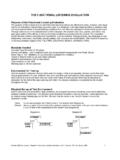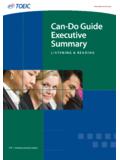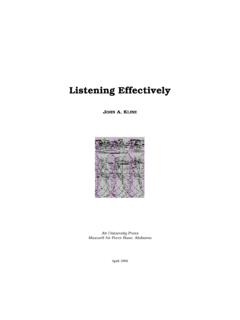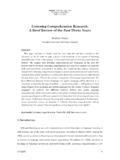Transcription of MAKE LISTENING SAFE Make Listening Safe - WHO
1 make LISTENING safe . make LISTENING safe ii make LISTENING safe . Concern is growing about the rising exposure to loud sounds in recreational settings such as nightclubs, discotheques, pubs, bars, cinemas, concerts, sporting events and even fitness classes. With the popularization of technology, devices such as music players are often listened to at unsafe volumes and for prolonged periods of time. Regular participation in such activities poses a serious threat of irreversible hearing loss. Cause for concern . The World Health Organization (WHO) estimates that billion young people worldwide could be at risk of hearing loss due to unsafe LISTENING practices.
2 Over 43 million people between the ages of 12 35 years live with disabling hearing loss due to different causes. Among teenagers and young adults aged 12 35 years in middle- and high-income countries: Nearly 50% are exposed to unsafe levels of sound from the use of personal audio devices. Around 40% are exposed to potentially damaging sound levels at clubs, discotheques and bars. Analysis of the National Health and Nutrition Examination Survey (NHANES) data from the United States suggests that between 1994. and 2006, the prevalence of hearing lossa among teenagers 12 to 19 years old rose significantly from to This rise may be expected to continue as the number of people LISTENING to music through headphones increased by 75% from 1990 to 2005 in the United States.
3 A 2008 European Commission report states that personal audio devices are being used by an increasing proportion of the population. The increasing sales of smartphones, with 470. million devices sold globally in 2011 alone, is another indicator of potential risk. This increased accessibility and use of personal audio devices for LISTENING to music is coupled with their use at high volume and for long durations. Such risk-associated behaviours can permanently damage hearing capacity. shutterstock a Hearing loss = A person has hearing loss if he or she is not able to hear or has a hearing threshold of 25 dB or more.
4 1. Once you lose your hearing, it won't come back! LESS TH. hr AN. min 1 SEC. Noise-induced hearing sec loss is irreversible. 130. 125. 120. Exposure to loud sounds for any length of time causes 115. fatigue of the ear's sensory cells. The result is temporary 110. hearing loss or tinnitus (a ringing sensation in the ear). A person enjoying a loud concert may come out 105. experiencing muffled' hearing or tinnitus. The hearing improves as the sensory cells recover. When the 100. exposure is particularly loud, regular or prolonged, it can cause permanent damage of the sensory cells and other 95.
5 Structures, resulting in irreversible hearing loss. The high- frequency range ( high-pitched sounds) is impacted 90. first and may not be noticeable immediately. Continued 85. exposure leads to progression of hearing loss, ultimately affecting speech comprehension and having a negative 80. impact on the individual's quality of life 75. sec Some people may be more susceptible to noise-induced 70. min 65. hearing loss than others. Genetic predisposition, chronic hr ED. 60. conditions such as diabetes and exposure to cigarette IT. M. smoke are known to increase the risk of acquiring noise- LI.
6 D. UN. ITE. ED. induced hearing loss. Because we cannot tell who the UNLIMITED. LIM. IMIT. most susceptible individuals are, prevention is the most UN. effective way to avoid such hearing loss. UNL. Noise-induced hearing loss can affect many aspects of life, including a person's social and educational development and their ability to work. Children and adults who live in noisy environments may face increased psychological stress and anxiety. In young children, noise-induced hearing loss hinders language acquisition. Learning disabilities, anxiety and attention-seeking behaviours are also common outcomes of hearing loss.
7 Chronic noise exposure in classrooms can impede academic performance in areas such as reading ability, comprehension, short- and long-term memory, and motivation. On average, children who are exposed to noisy learning environments have lower assessment scores on standardized tests. Noise exposure in young people also contributes to age-related hearing loss. Inadequate hearing protection during activities such as shooting firearms or LISTENING to loud music during adolescence may lead to significant communication difficulties much later in life. LISTENING to devices with earphones can also be unsafe in additional ways.
8 For example, use during walking or cycling decreases auditory perception and increases the listener's chances of being involved in a collision. 2. make LISTENING safe . Permissible daily What is safe LISTENING ? noise exposures safe LISTENING levels depend on the intensity (loudness), duration (length of time) and frequency (how often) of the exposure. These three factors are interrelated and contribute to the overall sound energy level that a person's ears are exposed to. The total amount of sound energy a person can safely receive is effectively constant. We can be exposed to the same amount of energy at lower volumes listened to over long periods of time as we might receive when louder sounds are heard for a short duration.
9 Permissible levels of daily exposure to noise have been identified accordingly, taking into account the total permissible dose' of sound. Permissible exposure levels have been calculated for occupational settings and are extrapolated to recreational settings. Eighty-five decibels is considered the highest safe exposure level E. IM. up to a maximum of eight hours. The permissible time T. G for safe LISTENING decreases as sound levels increase. IN. TEN For example, a sound as high as 100 dB the level S A FE LIS produced by a subway train can be safely listened to for only 15 minutes each day.
10 The output of personal audio devices may range from 75 dB to as high as 136 dB . The maximum output levels vary depending upon regulations and legislation in different countries. Typically, users of personal audio devices choose to set the volume between 75. to 105 dB. At nightclubs, discotheques and bars, average sound levels can range from 104 to 112 dB; noise levels at pop concerts may be even higher. Patrons may expose themselves to the same level of loudness in 15 minutes of music at 100 dB that an industrial worker gets in an 8-hour day at 85. dB. Noise levels at sporting venues have been found to range from 80 dB to 117 dB.
















